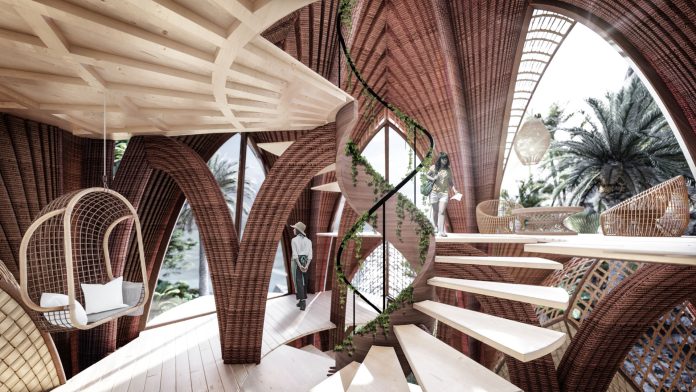As 3D printed building continues to push the boundaries of design, we explore the solutions and challenges it offers the industry.
The development and technology behind 3D printed building is becoming more innovative and successful as each new project is completed, with global teams of experts pushing the boundaries of design.
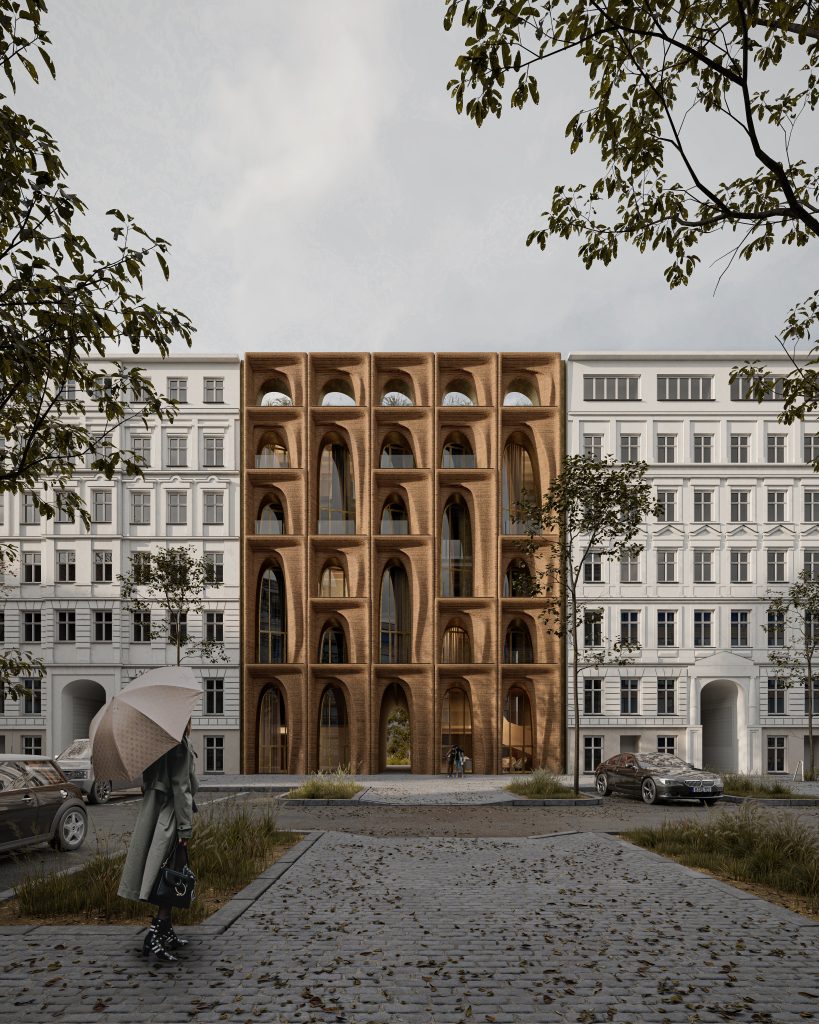
The architecture, engineering, and construction industry have taken on the challenge of coming up with solutions to support the housing crisis whilst continuing to create designs that inspire and ensure better buildings for the future.
As 3D printed building offers an exciting array of possibilities, such as mass/fast production and sustainable and affordable options, we asked a panel of industry experts: How can 3D printed building help housing emergencies whilst still creating design-led residences?
EDOUARD CABAY, ALEXANDRE DUBOR & YARA TAYOUN, IAAC
“By 2050, 68% of the world population is projected to live in urban areas. Meanwhile, the global aim in reducing global carbon dioxide (CO2) emissions to net zero by 2050 presents a great challenge to the construction industry, today responsible for 40% of those emissions from construction material manufacturing to building processes.
With the recent emergence of a multitude of 3d printed building solutions, the application of additive manufacturing in the construction sector demonstrates further possibilities for more optimised, sustainable, and customised constructions for our buildings and cities. (A. Dubor et all, 2018). In this context, IAAC continues its research towards 3D printing architecture with an aim to develop realistic architectural solutions that use additive manufacturing to provide sustainable, affordable and community-based processes of housing construction.
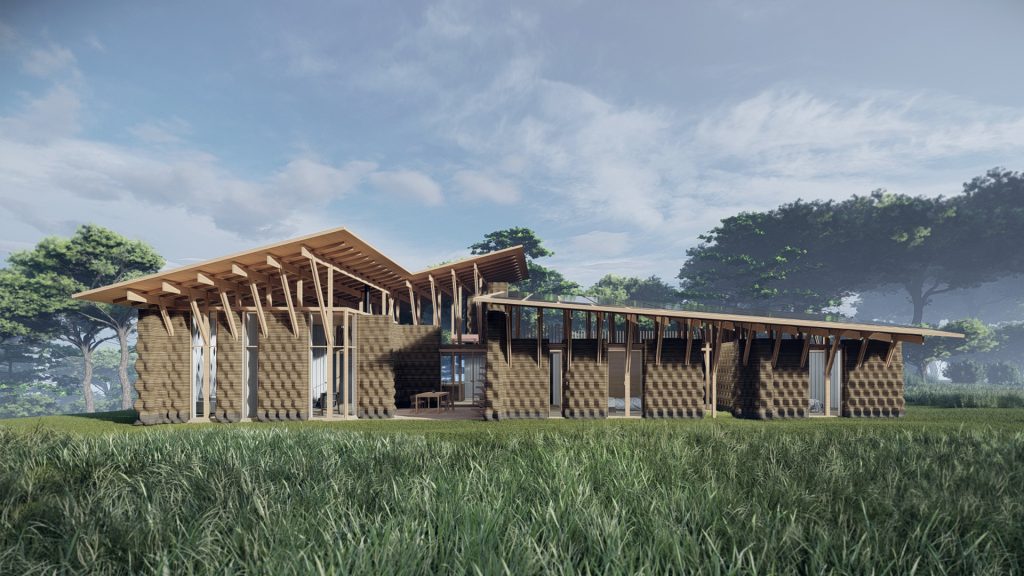
On-site continuous printing from locally sourced materials presents a great advantage in reducing the carbon footprint of buildings, by saving on material transportation as well as material processing, as the earth is extracted from the construction site and used in its raw state upon collection. The material goes through a natural process of sifting in order to achieve the desired particle scale ready for printing.
Relying on on-site printing techniques and natural resources ensures the circularity of the construction process, as no chemical modification is needed to recycle the building once it reaches its end of life, hence avoiding any contamination. The printed earth layers are deposited back on site, where the material was sourced from, guaranteeing a closed loop of circularity.
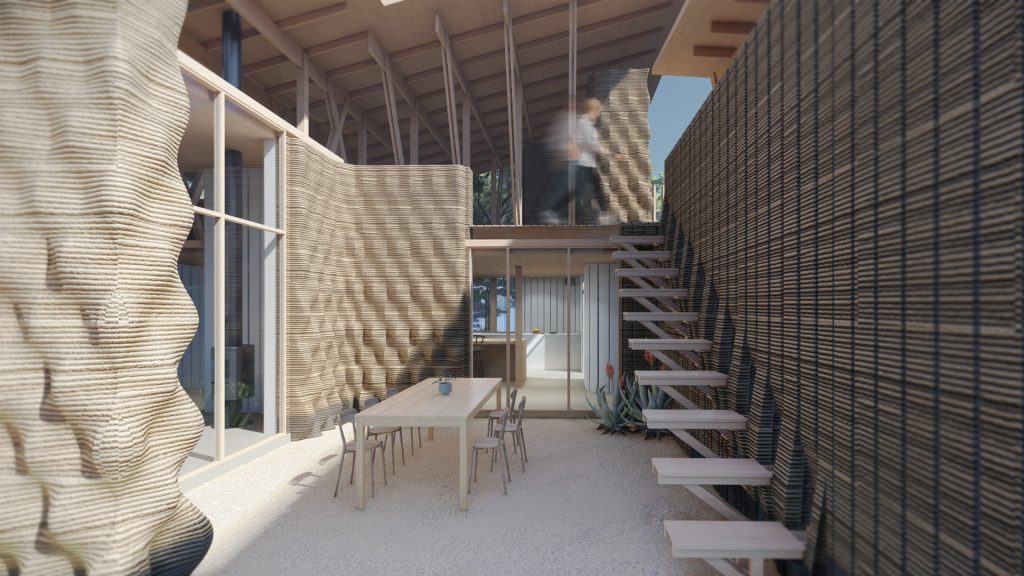
TOVA, a recently completed project with local earthen materials in the natural park of Collseolla, in the outskirts of Barcelona, certifies the potentials of 3d printing with sustainable materials, in response to the current climate challenges and housing emergencies. The result is a weatherproof prototype constructed with 100% natural and locally sourced material. Despite its small scale (9 sqm), TOVA contains all the technical details and features that a larger house would require: an integrated timber roof structure, a passive ventilation system, door and window embedded framing systems, insulation, services, integrated furniture… It therefore serves to demonstrate the possibility of the construction of a larger domestic building.
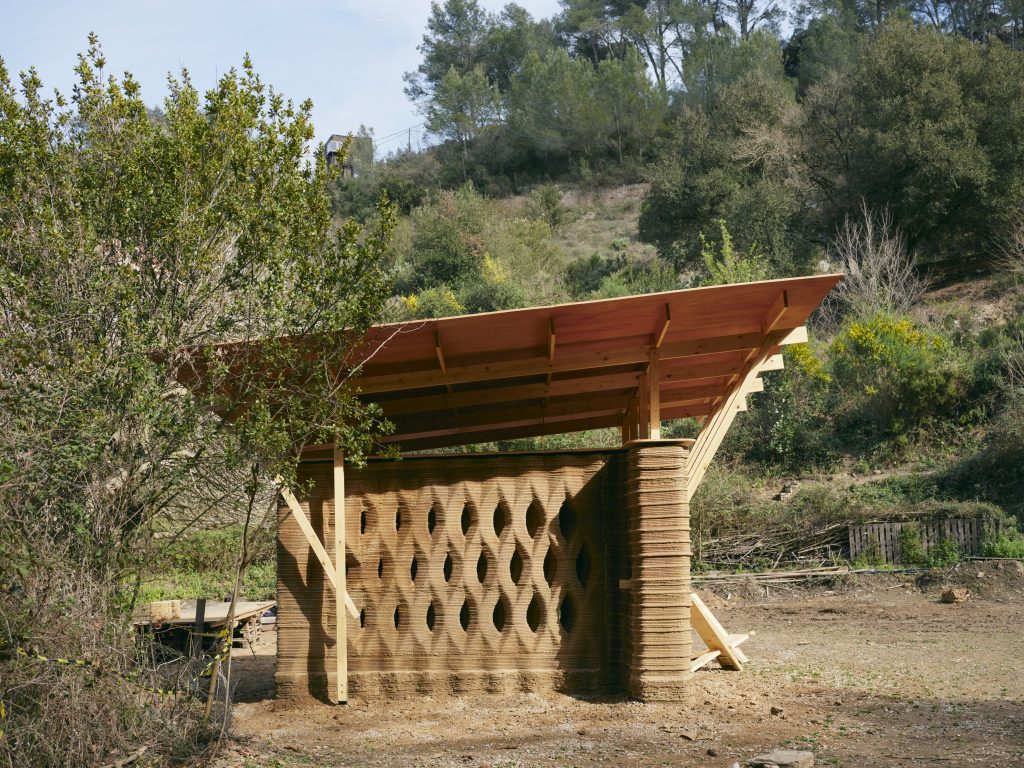
TOVA is the first 3D printed earthen construction in Spain, spanning a construction of 7 weeks (4 weeks of printing) exclusively with materials from a 50m radius. The building is composed of a stone foundation, 3D printed earth walls, a timber roof structure and wooden carpentry. The prototype is printed using 3D Wasp’s modular crane. The building design is based on a precise analysis of the climate condition of the Mediterranean. The volume is compact to protect from the cold in winter, yet expandable for the other three seasons, considering semi exterior spaces as part of the living space. For this purpose, the wall section, composed of 6 earth surfaces and a network of cavities that either contain air, or insulation, was calculated to prevent heat loss in the winter, while protecting from solar radiations in summer.

The design is researched and tested via digital and physical simulations in an effort to reduce construction footprints, monitor the reduction of CO2, and take into account the Life Cycle Assessment of the building components.
This prototype has rendered possible and riskless the application of 3d printed earthen construction in an adapted environment, merging both material knowledge and craftsmanship with cutting-edge optimised design technology.” – www.iaac.net
ALVISE SIMONDETTI, GLOBAL LEADER, ARUP

“The decades-long housing crisis in the UK shows no sign of abating. Instead, the need for affordable housing is growing ever greater, with rental prices and mortgage rates exacerbating the issues in the sector during a cost of living crisis. Current demand is outstripping supply as the government scrambles to meet its housebuilding target of 300,000 homes a year by the mid-2020s within its decarbonization commitments.The construction sector needs to be equipped to respond, without compromising on quality, design, or sustainability. And it must do so despite setbacks in labour shortages and the rising cost of materials, meaning innovative digital solutions will be essential.
3D printed building, or “additive manufacturing”, makes it possible to build bespoke, high performance physical components layer by layer directly on-site using 3D printers on movable bases. Arup has been a core part of the development of this technology. Since 2014, it has been pushing the boundaries of designing with 3D printing to ensure it will one day be ready to enter the realm of real-world, hard-hat construction. Arup is also currently sponsoring novel research at UCL Robotics in Autonomous Mobile 3D Printing of Large-Scale Trajectories.

A key milestone came in 2018 when Arup, alongside CLS Architects, unveiled a temporary 3D printed house in central Milan. It was the first of its kind in the EU, due to its robotic manipulator being mounted on a movable base. The whole house was printed on-site by CyBe Construction portable robot, taking a total of just 48 cumulative hours. Built “live” over 10 days in the centre of Milan under pressure to meet the opening of international Salone del Mobile, while continuously adapting the digital model to the feedback from site. Furthermore, it was taken apart and reassembled elsewhere.
Such agility dramatically increased the efficiency of the process while remaining commercially viable. Both points are likely to be key criteria in solving the UK’s housing emergency. The possibilities for mass customisation are also invaluable. The shape and design can be optimised to ensure each model fits the demands of specific locations.

3D printed housing could also solve other longstanding issues associated with the construction industry, which is widely regarded as one of the world’s biggest users of resources. This technology has the potential to slash the carbon footprint of the sector, by drastically reducing material consumption and site waste. Furthermore, it allows components to be re-used at the end of a building’s life, rather than ending up as landfill.
In summary, 3D printing provides a unique opportunity to rapidly test and discover new and improved ways to redefine the built environment. As a result, the industry must not be afraid to embrace digital design workflows in all stages of the building process. New technologies combined with creative thinking have a fundamental role to play in addressing today’s construction challenges, transforming how we build residences in the UK.” – www.arup.com
HENRIK LUND-NIELSEN, FOUNDER & GENERAL MANAGER, COBOD INTERNATIONAL

“COBOD is working tirelessly to contribute to a significant transformation of the global construction industry and a better tomorrow. 3D printing is one of the world’s most promising technologies as 3D printed homes can combine design, functionality, low costs, and environmental benefits as this building method reduces the CO2 footprint compared to conventional construction.
I see 3D printing technology as a real game-changer in construction as it can address housing emergencies but also be part of bringing new architecture to life that would otherwise not have been possible by conventional brick and mortar methods.

One prominent example of this is the BOD building. It is Europe’s first 3D printed building and located in Copenhagen, Denmark. We 3D printed the BOD in 2017 as a testament to how the technology of 3D construction printing can disrupt the conventional construction methods of today. Even though the BOD is less than 50 square meters (538 sq ft) in size, it is still large enough to demonstrate some of the economic and architectural benefits of using 3D printing technology for construction. To emphasize the design freedom of 3D printing, the BOD does not have a single straight wall. Here it is worth noting that 3D printing allows for curved wall designs without adding any complexity or further costs.

Europe’s first 3D printed office extension recently opened in Hausleiten in Austria. This project is a result of a collaboration between the construction technology group STRABAG and the scaffolding and formwork manufacturer and 3D concrete printing pioneer PERI. The building is a 125 m2 office extension to an existing building in Hausleiten. 3D printing in general allows design freedom compared to classic concrete construction, such as architecturally appealing rounded shapes. This office building in Austria impresses with its unusual architectural form and the structures of the printed concrete are recognizable as a design element on the facade, which gives the building a special appearance in addition to the cloverleaf shape.

Many of our partners also use the COBOD International 3D construction printers to address the global housing crisis. 14Trees in Kenya and Malawi is building the first affordable housing communities and schools of the future with our 3D construction printer. 14Trees achieved tremendous results applying COBOD’s technology resulting in reduced cost, time, and materials compared to traditional methods. Furthermore, the building has an environmental footprint of 50% compared to the conventional building methods in Africa.
Sustainability is an important factor to this new automated construction method. 3D construction printing allows for sourcing locally to reduce transportation, minimizing waste on-site, and constructing buildings that last. Through our latest innovation, with our partner CEMEX, we reduced the cement share by 30% compared with industry standards of 3D construction printing. As such COBOD International sees 3D printed buildings playing an important part in remedying the housing emergencies whilst still creating design-led residences.” – www.cobod.com



